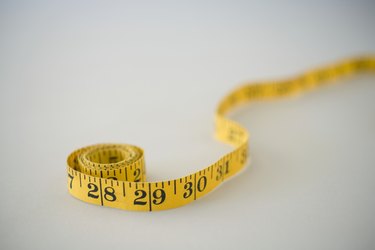
You can't determine your body composition solely by your height and wrist size. Wrist size varies from person to person, and typically is associated with overall frame size rather than with body composition. The only way to obtain an accurate idea of your body composition is to measure your body fat percentage. Adding other measurements to the calculations, such as waist circumference and weight, can give you a good idea if you're at a healthy weight and wrist size for your height.
Wrist Size and Frame Size
Video of the Day
Knowing your frame size allows you to estimate a healthy weight range for your body. Wrist circumference is often used for determining frame size, since people who with larger frames also have larger wrists.
Video of the Day
For example, a man over 5 foot 5 inches tall, and a wrist that measures 6.5 to 7.5 inches around, has a medium frame.
A woman over 5 foot 5 inches tall, and a wrist that measures 6.25 to 6.5 inches around, has a medium frame.
A woman under 5 foot 2 inches tall, and a wrist between 5.5 and 5.75 inches around has a medium frame.
A woman between 5 foot 2 inches and 5 foot 5 inches, with a wrist that measures between 6 to 6.25 inches around, has a medium frame.
Frame Size and Healthy Weight
People who have larger frames can be healthy at a higher weight than people who have with smaller frames. Thus, a 5-foot 7-inch tall man with a medium frame should weigh between 142 and 154 pounds, but a man of the same height with a large frame may be healthy if he weighs from 149 to 168 pounds.
Women tend to have smaller frames than men, so they should weigh less, even at the same height. For example, a 5-foot 7-inch tall woman with a medium frame should be between 133 and 147 pounds, and a woman with a large frame should be between 143 and 163 pounds.
Body Mass Index
Doctors often use body mass index as a way to estimate whether a person has a healthy body composition, even though BMI doesn't actually measure body fat. BMI equations use height and weight to indicate whether a person is most likely at a healthy weight for their size. Wrist size isn't included in that calculation.
Using an online BMI calculator is the easiest way to figure out your BMI, but you can also multiply your weight in pounds by 703 and divide the result by your height in inches squared. Any result between 18.5 and 24.9 falls within the normal range. This means, a 5-foot 7-inch tall man or women has a healthy BMI if he or she weighs from 121 to 153 pounds.
Waist-to-Height Ratio
The BMI doesn't take into consideration where you carry your extra weight. Having a large wrist isn't associated with any particular health problem, but having a stomach that's too large can indicate you have an excessive amount of a dangerous type of fat around your organs, called visceral fat. Visceral fat increases your risk for gallbladder problems, type 2 diabetes, breast cancer and heart disease.
The waist-to-height ratio takes this into consideration, which is part of the reason why the WHtR may be a better screening tool than BMI for predicting heart disease risk, according to a review article published in "Obesity Reviews" in 2012. Women should have a WHtR between 0.42 and 0.49, and men should have a WHtR between 0.43 and 0.53.
This means a 5-foot 7-inch tall woman should have a waist measuring between 29 and 32 inches; a man the same height should have a waist circumference between 29 and 35 inches.
Determining Body Composition
Typically, people have between 60 and 90 percent lean body mass and between 10 and 40 percent body fat. You can use an online lean body mass calculator to get an idea of the average body composition of people the same gender, age, weight and height as yourself. To determine your body composition accurately, however, you'll need to have your body fat percentage measured.
Some health clubs and gyms have staff trained to do this, using skin calipers, which pinch skin at different points to calculate body fat, or handheld bioelectrical impedance analysis scanners. BIA scanners send a signal through your body and determine body fat based on how long it takes to travel through your body.
Fat slows the signal down, so the longer it takes, the higher your body fat percentage. Home scales sometimes use BIA to estimate body fat, but they aren't particularly accurate. It is best to use a scale to see if your body fat is going up or down, rather than to determine the exact amount of body fat you have. If you're really concerned, you can ask your doctor to order a full body scan, such as a CT scan or MRI, or find a place that offers underwater weighing, which is a more accurate but expensive method for measuring body fat.
- Hamilton Healthcare System: Finding Your Ideal Body Weight
- Centers for Disease Control and Prevention: About Adult BMI
- American Cancer Society: Normal Weight Ranges: Body Mass Index (BMI)
- Obesity Reviews: Waist-to-Height Ratio Is a Better Screening Tool Than Waist Circumference and BMI for Adult Cardiometabolic Risk Factors: A Systematic Review and Meta-Analysis
- ShapeFit.com: Waist to Height Ratio Calculator – Assess Your Lifestyle Risk
- Harvard Medical School: Abdominal Fat and What to Do About It
- Calculator.net: Lean Body Mass Calculator
- QuickAndDirtyTips.com: How to Measure Body Fat
- Consumer Reports: Scale Buying Guide